Geocaching
Geocaching (/ˈdʒiːoʊkæʃɪŋ/, JEE-oh-KASH-ing) is an outdoor recreational activity, in which participants use a Global Positioning System (GPS) receiver or mobile device and other navigational techniques to hide and seek containers, called geocaches or caches, at specific locations marked by coordinates all over the world.[3] As of 2023, there are over 3 million active caches worldwide.[4]
 International Geocaching Logo[1] | |
| Nicknames | Caching, treasure hunting |
|---|---|
| First played | May 3, 2000[2] Beavercreek, Oregon |
| Characteristics | |
| Team members | Optional |
| Type | Recreational activity |
| Equipment | GPS receiver or GPS-enabled mobile device, writing implement |
| Presence | |
| Country or region | Worldwide |
Geocaching can be considered a location-based game. A typical cache is a small waterproof container containing a logbook and sometimes a pen or pencil.[5] The geocacher signs the log with their established code name/username and dates it, in order to prove that they found the cache. After signing the log, the cache must be placed back exactly where the person found it. Larger containers such as plastic storage containers (Tupperware or similar) or ammo boxes can also contain items for trading, such as toys or trinkets, usually of more sentimental worth than financial.[6] Geocaching shares many aspects with benchmarking, trigpointing, orienteering, treasure hunting, letterboxing, trail blazing, and Munzee.
History

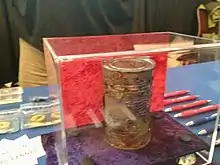
Geocaching was originally similar to the game letterboxing (which originated in 1854), which uses clues and references to landmarks embedded in stories.[7][8] Geocaching was conceived shortly after the removal of Selective Availability from the Global Positioning System on May 2, 2000 (Blue Switch Day[9]), because the improved accuracy[10] of the system allowed for a small container to be specifically placed and located.[8][11]
The first documented placement of a GPS-located cache took place on May 3, 2000, by Dave Ulmer of Beavercreek, Oregon.[12] The location was posted on the Usenet newsgroup sci.geo.satellite-nav[13] at 45°17.460′N 122°24.800′W. Within three days, the cache had been found twice, first by Mike Teague.[14] According to Dave Ulmer's message, this cache was a black plastic bucket that was partially buried and contained software, videos, books, money, a can of beans, and a slingshot.[13] The geocache and most of its contents were eventually destroyed by a lawn mower; the can of beans was the only item salvaged and was turned into a trackable item called the "Original Can of Beans".[15][16] Another geocache and plaque, called the Original Stash Tribute Plaque, now sits at the site.[15]
Geocaching company Groundspeak allows extra-terrestrial caches, e.g. the Moon or Mars, although presently, the website provides only earthbound coordinates. The first published extra-terrestrial geocache was GC1BE91, which was on the International Space Station between 2008 and 2017.[17] It used the Baikonur launch area in Kazakhstan as its position.[18] The original cache contained a travel bug (the first geocaching trackable item in space), which stayed on the station until it was brought back to earth in 2013. Due to fire restrictions on board the station, the geocache contained no official paper logbook. As of February 2021, only one confirmed geocacher (in 2013) has actually found the geocache,[19] although others have claimed to have found it providing varying amounts of evidence. To commemorate the occasion, Groundspeak allowed specialized geocaching events to be published across the world, allowing attendees to obtain a virtual souvenir on their profile.
The second geocaching trackable in space is TB5EFXK [20] which is attached to the SHERLOC calibration target on board the Mars Perseverance Rover, which landed on Mars on 18 February 2021.[21] Geocachers were given the opportunity to virtually discover the trackable after the WATSON camera sent back its first photographs of the calibration target that contained the tracking code number. The code is printed on a prototype helmet visor material that will be used to test how well it can withstand the Martian environment. This will help scientists in creating a viable Martian spacesuit for future crewed missions to Mars.
The activity was originally referred to as the GPS stash hunt or gpsstashing. This was changed shortly after the original hide when it was suggested in the gpsstash eGroup that "stash" could have negative connotations and the term geocaching was adopted.[22]
Over time, a variety of different hide-and-seek-type activities have been created or abandoned, so that "geocaching" may now refer to hiding and seeking containers, or locations or information without containers.[23]
An independent accounting of the early history documents several controversial actions taken by Jeremy Irish and Grounded, Inc., a predecessor to Groundspeak, to increase "commercialization and monopolistic control over the hobby".[24] More recently, other similar hobbies such as Munzee have attracted some geocachers by rapidly adopting smart-phone technology, which has caused "some resistance from geocaching organizers about placing caches along with Munzees".[25]
Geocaches
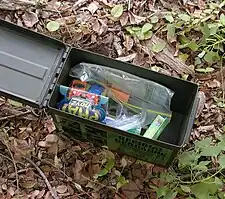
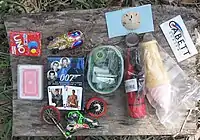
For the traditional geocache, a geocacher will place a waterproof container containing a log book, often also a pen and/or pencil and trade items or trackables, then record the cache's coordinates. These coordinates, along with other details of the location, are posted on a listing site (see list of some sites below). Other geocachers obtain the coordinates from that listing site and seek out the cache using their handheld GPS receivers.[8] The finding geocachers record their exploits in the logbook and online, but then must return the cache to the same coordinates so that other geocachers may find it. Geocachers are free to take objects (except the logbook, pencil, or stamp) from the cache in exchange for leaving something of similar or higher value.[26]
Typical cache "treasures", also known in the geocaching world as SWAG (a backronym of "stuff we all get"),[27][28] are not high in monetary value but may hold personal value to the finder.[26] Aside from the logbook, common cache contents are unusual coins or currency, small toys, ornamental buttons, CDs, or books. Although not required, many geocachers decide to leave behind signature items, such as personal geocoins, pins, or craft items, to mark their presence at the cache location.[27] Disposable cameras are popular as they allow for anyone who found the cache to take a picture which can be developed and uploaded to a Geocaching web site listed below.[29] Also common are objects that are moved from cache to cache called "hitchhikers", such as Travel Bugs or geocoins, whose travels may be logged and followed online.[30] Cachers who initially place a Travel Bug or geocoin(s) often assign specific goals for their trackable items. Examples of goals are to be placed in a certain cache a long distance from home, or to travel to a certain country, or to travel faster and farther than other hitchhikers in a race. Less common trends are site-specific information pages about the historic significance of the site, types of trees, birds in the area or other such information. Higher-value items are occasionally included in geocaches as a reward for the First to Find (called "FTF"), or in locations which are harder to reach.
Dangerous or illegal items, including weapons and drugs, are not allowed and are specifically against the rules of most geocache listing sites. Food is also disallowed, even if sealed, as it is considered unhygienic and can attract animals.
If a geocache has been vandalized or stolen by a person who is not familiar with geocaching, it is said to have been "muggled".[31][32] The term plays off the fact that those not familiar with geocaching are called muggles, a word borrowed from the Harry Potter series of books which were rising in popularity at the same time geocaching started.[27]
Variations
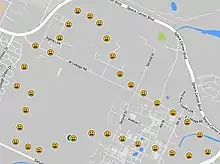
Traditional geocaching gave birth to GeoCaching – an active urban game of the Encounter project. The game is quite similar to geocaching but has time limitations and hints.
Geocaches vary in size, difficulty, and location. Simple caches that are placed near a roadside are often called "drive-bys", "park 'n grabs" (PNGs), or "cache and dash". Geocaches may also be complex, involving lengthy searches, significant travel, or use of specialist equipment such as SCUBA diving, kayaking, or abseiling. Different geocaching websites list different variations per their own policies.
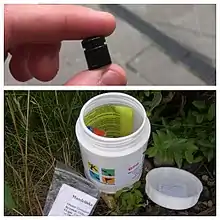
Bottom: a large bucket geocache in the Czech Republic.
Container sizes range from nano, particularly magnetic nanos, which can be smaller than the tip of a finger and have only enough room to store the log sheet, to 20-liter (5 gallon) buckets or even larger containers, such as entire trucks.[33] The most common cache containers in rural areas are lunch-box-sized plastic storage containers or surplus military ammunition cans. Ammo cans are considered the gold standard of containers because they are very sturdy, waterproof, animal- and fire-resistant, and relatively cheap, and have plenty of room for trade items. Smaller containers are more common in urban areas because they can be more easily hidden.
Geocache types
Over time many variations of geocaches have developed. Different platforms often have their own rules on which types are allowed or how they are classified. The following cache types are supported by geocaching.com.
- Traditional geocache
- The most common type of geocache and consists of a container with a logbook. Exact coordinates where the cache is located are provided.[34]
- Multi-cache
- One or more stages, each of which containing the coordinates for the next one; the final stage contains a physical container with the logbook.[34][35] Multi-caches can consist of physical stages (i.e. the first stage contains coordinates for the next stage and so forth) or virtual stages (i.e. the first stage is a historical marker where geocachers have to answer questions to calculate the coordinates to the final physical container).
- Mystery or puzzle cache
- This require users to solve a puzzle in order to get the exact coordinates for the geocache. The posted coordinates of mystery caches are usually bogus. [34] Some puzzles can be easy and involve basic math operations or they can be quite difficult, with some of the more challenging ones requiring a firm understanding of computer programming. Geocaching Toolbox, a website dedicated to create and solve puzzle geocaches, provides a comprehensive list of common puzzle cache ciphers.
Mystery-type
Geocaches that do not fit into other categories are usually classified as mystery-type caches. Some examples listed below:
- Challenge cache
- This requires a geocacher to complete a reasonably attainable geocaching-related task before being able to log the cache as a find online.[36] It does not restrict geocachers from finding the cache and signing the logbook at anytime. However a geocacher is not allowed to log a find on the geocaching website unless they qualify for the challenge specified in the cache description. Examples include finding a number of caches that meet a category, completing a number of cache finds within a period of time, or finding a cache for every calendar day.
Since 2017, Groundspeak has required new challenges to have a geochecker in which users can put their name into an algorithm to see if they qualify without the need of physically checking all of one's previous finds. These geocheckers can be requested using the ProjectGC forums where volunteers can write and create scripts for specific challenges. Groundspeak also has been more strict into what types of challenges are published. For example, prior to 2017 it was possible to create a challenge cache to find 10 caches that have a food item in the title. Under current guidelines, this is no longer allowed because it restricts geocachers to find specific geocaches. Instead, Groundspeak has encouraged new challenges to be more creative. Acceptable challenges include finding caches in 10 states, finding 100 traditional geocaches, or finding 1000 geocaches with the "wheelchair accessible" attribute.
- Moving or travelling cache
- These are found at a listed set of coordinates. The finder hides the cache in a different location, and updates the listing, essentially becoming the hider, and the next finder continues the cycle. This cache has been discontinued at geocaching.com and those that have been grandfathered in are solely declining and are being archived. [35][37]
- Chirp cache
- Also known as a wireless beacon cache. This is a Garmin-created innovative on multi-caches using wireless beacon technology. It is a physical game piece, about the size of a half dollar that can be hidden anywhere. Powered by a small battery, it is able to transmit a signal detectable on Garmin devices. The Chirp stores hints, multicache coordinates, counts visitors, and can confirms the cache is nearby. [38][39] These caches caused considerable discussion and some controversy at Groundspeak, where they were ultimately given a new "attribute".[34][40] These types of geocaches can also be listed as a traditional, multi-cache, or letterbox. It is up to the cache owner to designated the cache type for wireless beacon caches.
- Night cache
- These are multi-stage and intended to be found at night by following a series of reflectors with a flashlight to the final cache location. Considered a variant of the Mystery cache on geocaching.com.[41]
- Geocaching HQ Geocache (GCK25B)
- This is an official geocache located inside the Groundspeak headquarters office in Seattle, Washington. It is technically classified as a separate cache type under mystery caches, with its own unique icon both on the geocaching app and on one's profile statistics tab. Since publication in 2004, it has nearly 20,000 finds as of August 2023.[42]
- Wherigo cache
- A multi-stage cache hunt that uses a Wherigo "cartridge" to guide players to find a physical cache sometime during cartridge play, usually at the end. However, not all Wherigo cartridges incorporate geocaches into gameplay. Wherigo caches are unique to the geocaching.com website.[34] Wherigo is a GPS location-aware software platform initially released in January 2008. Authors can develop self-enclosed story files (called "cartridges") that are read by the Wherigo player software, installed on either a GPS unit or smartphone. The player and story take advantage of the location information provided by the GPS to trigger in-game events, such as using a virtual object or interacting with characters. Completing an adventure can require reaching different locations and solving puzzles. Cartridges are coded in Lua. Lua may be used directly, but a builder application is usually used. The Wherigo site[43] offers a builder application and a database of adventures free for download, though the builder has remained in its Alpha version since its last release in May 2008.[44] The official player is only available for Pocket PC. A built-in player is available on Garmin Colorado and Oregon GPS models. The Wherigo Foundation[45] was organized in December 2012. The group is composed of all Wherigo application developers who, up until that time, had been acting and developing separately. Their goal is to provide a consistent Wherigo experience across platforms, connect Wherigo applications via an API, and add modern features to the Wherigo platform. While Groundspeak is aware of this project, the company has yet to take a position.
- Reverse Wherigo
- An RWIG provides three lines of code composed of 9 digits each that a player can type into the RWIG cartridge. Instead of following a story or interacting with characters, and RWIG gives you the distance to the final cache, but not direction. It requires geocachers to get closer to the final geocache by process of elimination. Once you are within 25 yards, the final coordinates are given to provide a more accurate location for the geocache.
- Letterbox cache
- (Also known as a letterbox hybrid cache.) This is a combination of a geocache and a letterbox in the same container. A letterbox has a rubber stamp and a logbook instead of tradable items. Letterboxers carry their own stamp with them, to stamp the letterbox's log book and inversely stamp their personal log book with the letterbox stamp. The hybrid cache contains the important materials for this and may or may not include trade items.[34][35] Typically, letterboxes are not found at the given coordinates which only act as a starting location. Instead, a series of clues are given as to where to find the cache such as "take a left past the bridge" or "about 25 paces past the big oak tree".
- Project A.P.E.
- (Also simply Ape Caches.) These are a special type of traditional geocache that were hidden in conjunction with 20th Century Fox and Groundspeak to promote the 2001 remake of Planet of the Apes. There were 14 APE geocaches placed around the world and each one contained a prop from the film. As of 2023, only 2 APE caches are still active with one near Seattle, Washington ('Tunnel of Light', GC1169) and the other in Brazil ('Southern Bowl', GCC67). Of those two, the Brazil APE cache is the only surviving original APE cache because GC1169 was muggled in 2016. However, the original container was later found by a Groundspeak led survey in April of that year. What remains of "Tunnel of Light" is an "official" replacement of the original ammo can that was left in 2001.
Virtual Geocaches
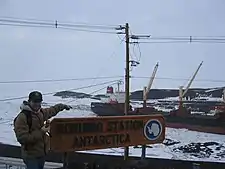
The following cache types don't contain a physical logbook. Groundspeak created a waymarking website to handle all other non-physical caches.[46]
- Virtual cache
- Coordinates for a rather interesting or unique location, usually with a described object such as an art sculpture or a scenic lookout. Validation for finding a virtual cache generally requires one to email the cache hider with information such as a date or a name on a plaque, or to post a picture of oneself at the site with a GPS receiver in hand.[34] As of 2005, new virtual caches are no longer allowed by Groundspeak as it is considered a legacy cache. [47]
On August 24, 2017, Groundspeak announced "Virtual Rewards", allowing 4000 new virtual caches to be placed during the following year.[48] Each year, eligible geocachers can opt-in to a drawing and some selected with the opportunity to submit a virtual cache for publication. From 2005 to 2017, the geocaching website no longer listed new caches without a physical container, including virtual and webcam caches (with the exception of earthcaches and events); however, older caches of these types have been grandfathered in (except for locationless or reverse, which are completely archived and transferred to Waymarking.com).
- EarthCache
- A type of virtual geocache that is published not by a local reviewer, but by a volunteer regional reviewer associated with the Geological Society of America. The cacher usually has to perform a task which teaches an education lesson about the geology of the cache area.[49] [34] Visitors must answer geological questions to complete the cache which can be as simple as describing the color and thickness of layers in an outcrop or can be as complicated as taking measurements of stream velocities or fault offsets. Earthcaches covers geologic topics such as: rock formation, mineralogy, earthquakes, fluvial processes, erosion, volcanology, and planetary science (among others).
- Locationless (reverse) cache
- Similar to a scavenger hunt. A description is given for something to find, such as a one-room schoolhouse, and the finder locates an example of this object. The finder records the location using their GPS receiver and often takes a picture at the location showing the named object with their GPS receiver. Typically others are not allowed to log that same location as a find.[34]
Since 2005, all locationless caches have be archived and locked, meaning they are unable to be logged. However, with geocaching's 20th anniversary in 2020 Groundspeak decided to publish a special locationless cache for geocachers to "find" at various Mega and Giga events around the world. The first locationless geocache in 15 years (GC8FR0G) required finders to take a picture of themselves with the geocaching mascot, Signal the Frog, at Mega and Giga Events during 2020. The cache was made available to log starting 1 January 2020. However, because of the COVID-19 pandemic, nearly all planned Mega and Giga events were canceled for the year, including the planned 20th anniversary celebration event in Seattle, Washington. Therefore, Groundspeak decided to extend the deadline to log this geocache through 1 January 2023. With 22,500 finds it is the second most logged geocache in history.
The second published locationless cache since 2005 (GC8NEAT) required visitors to take a photo of them picking up trash and cleaning up their local area. Geocachers were able to log this cache from 6 February 2021 through 31 December 2022. It has been logged over 33,500 times and holds the title for the most "found" geocache. On 17 August 2022, Geocaching made available the 3rd locationless cache to be logged since 2005 (GC9FAVE). Instead of finding Signal or picking up trash, this cache encouraged geocachers from around the world to share their favorite geocaching story. This geocache will be archived and locked on 1 January 2024.
- Webcam caches
- A type of virtual cache whose coordinates provide the location to a public webcam. The finder is required to capture an image of themselves through the webcam for verification of the find.[34] New webcam caches are no longer allowed by Groundspeak as it is a legacy cache.[47] Webcam caches are a category at Waymarking.com.
- Adventure Lab cache (AL)
- A type of virtual cache that typically consists of a set of 5 or 10 waypoints, with each waypoint counting as a "cache find". The waypoints usually have an overall theme such showcasing the history of a small town and are often created as a walking tour of a city or park. An example would be Route 66 or the Lincoln Highway, which are a nationwide series of AL sets of 10 that stretch the entire route across the United States.
Adventure labs were first introduced in 2014 as a way to test market ideas through Groundspeak. Initially, geocachers would find a key word at a designated site where they could then enter it onto a website to claim "credit". Soon after, they were made available to "find" at select mega events. In 2020, Groundspeak released the "Adventure Lab" app, separate from the Geocaching app. The app made it possible to enter a geo-fence when, once inside, a question will appear that can be answered either in the form of a written answer or a multiple choice answer. This question can be answered at anytime once activated, however, some ALs must be completed sequentially implying that one must answer the question to move on to the next waypoint.
Most, but not all, ALs have a physical bonus cache associated with them that are listed as a "mystery cache". Coordinates to the bonus cache, if applicable, can be seen in the journal entries once a user has correctly answered the question at a waypoint.
Geocachers can create their own Adventure Lab, but must first opt-in to receive an "adventure lab credit" which allows for the creation of 1 set of 5 waypoints, with each of the 5 waypoints counting towards a cache find. If selected, ALs can be created using the Adventure Lab builder. Adventure Labs, unlike all other geocachers, are not subject to review and are published at will by the creator. However, ALs can at anytime be archived by Groundspeak if they are in violation of terms of use. For example, placing an adventure lab in a place that requires people to pay a fee to visit such as airports or theme parks may get the adventure permanently removed from the Adventure Lab app. Adventure Labs are created using the Adventure Lab builder.
Events
There are several kinds of events geocaches. While encouraged, events do not require visitors to sign their name a logbook to prove they attended an event. Attendees of event caches can log that they 'attended', which will increment their number of found caches.
- Event Cache
- A gathering organized and attended by geocachers. It is not a true cache, but is treated as such by geocaching platforms: it can be "found" upon attending the event.[34] Event caches have to be longer than 30 minutes, and can publish no less than 14 days away from the planned event date. Event caches typically last from 1 to 2 hours.
- Cache-In Trash-Out (CITO)
- Coordinated activities of trash pickup and other maintenance tasks (such as constructing footpaths, planting trees and removing invasive species) to improve the environment.[34] CITO is an ongoing environmental initiative created by Groundspeak and encourages geocachers to clean up parks and other areas in which they frequently visit while geocaching.[34] CITO events must be no less than 2 hours long. Just like event caches, CITOs have to be published no less than 14 days prior to the date of the CITO. CITO typically last from 2 to 4 hours.
- Mega Event
- A gathering that consists of 500 or more geocachers. Mega events are typically organized by a local geocache organizations in conjunction with local municipalities and promotion from Groundspeak. Often, mega events last an entire day and have various activities planned in the days before, during, and after the main mega event. These activities can range in raffles and silent auctions, of which funds help offset the costs of organizing such an event, photo ops with Signal the Frog, a plethora of new geocaches, and panels with local geocachers, lackeys (Groundspeak employees), and reviewers. Mega events often have vendors where people can purchase geocoins, cache containers, and food.
- Giga Event
- A gathering that consists of 5,000 or more geocachers. Like a Mega event, Giga Events offer a plethora of actives and are typically held in large areas to accommodate such crowds. Activities typically include a GPS Adventures Maze, panels, vendors, live music, and carnival rides. Usually the week before and after are filled with smaller gatherings which attracts geocachers from around the world who often make a vacation out of it.
- GPS Adventures Maze Exhibit
- An exhibit at various museums and science centers in which participants in the maze learn about geocaching. These "events" have their own cache type on geocaching.com and include many non-geocachers.[34] These are considered one of the rarest cache icon types because only a handful of GPS Adventures Maze Exhibits have existed, and typically only in the US. Although they are becoming more popular at or near Giga events.
- Community Celebration Event (CCE)
- A type of event that is meant to celebrate the 10th and 20th anniversary of geocaching. First issued in 2010 as "Lost and Found" events, geocachers could host one to celebrate the 10 year anniversary of geocaching. In preparation for the 20th anniversary in 2020, Lost and Found events were rebranded as Community Celebration Events. Geocachers could opt-in to receive a CCE credit to host. Due to the Covid-19 Pandemic Groundspeak allowed CCEs to be hosted until 31 December 2022. The next time CCEs will be available will be in 2030.
Technology
Obtaining data
GPX files containing information such as a cache description and information about recent visitors to the cache are available from various listing sites. Geocachers may upload geocache data (also known as waypoints) from various websites in various formats, most commonly in file-type GPX, which uses XML.[50] Some websites allow geocachers to search (build queries) for multiple caches within a geographic area based on criteria such as ZIP code or coordinates, downloading the results as an email attachment on a schedule. In recent years, Android and iPhone users can download apps such as GeoBeagle[51] that allow them to use their 3G and GPS-enabled devices to actively search for and download new caches.[52][53]
Converting and filtering data
A variety of geocaching applications are available for geocache data management, file-type translation, and personalization. Geocaching software can assign special icons or search (filter) for caches based on certain criteria (e.g. distance from an assigned point, difficulty, date last found).
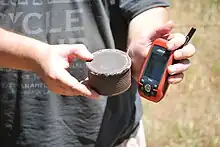
Paperless geocaching means hunting a geocache without a physical printout of the cache description. Traditionally, this means that the seeker has an electronic means of viewing the cache information in the field, such as pre-downloading the information to a PDA or other electronic device. Various applications can directly upload and read GPX files without further conversion. Newer GPS devices released by Garmin, DeLorme, and Magellan have the ability to read GPX files directly, thus eliminating the need for a PDA.[54] Other methods include viewing real-time information on a portable computer with internet access or with an Internet-enabled smart phone. The latest advancement of this practice involves installing dedicated applications on a smart phone with a built-in GPS receiver. Seekers can search for and download caches in their immediate vicinity directly to the application and use the on-board GPS receiver to find the cache.
A more controversial version of paperless caching involves mass-downloading only the coordinates and cache names (or waypoint IDs) for hundreds of caches into older receivers. This is a common practice of some cachers and has been used successfully for years. In many cases, however, the cache description and hint are never read by the seeker before hunting the cache. This means they are unaware of potential restrictions such as limited hunt times, park open/close times, off-limit areas, and suggested parking locations.
Mobile devices
The website geocaching.com[55] now sells mobile applications which allow users to view caches through a variety of different devices. Currently, the Android, iPhone, and Windows Phone mobile platforms have applications in their respective stores. The apps also allow for a trial version with limited functionality. The site promotes mobile applications, and lists over two dozen applications (both mobile and browser/desktop based) that are using their proprietary but royalty-free public application programming interface (API).[56] Developers at c:geo have criticised Groundspeak for being incompatible with open-source development.[57]
Additionally "c:geo - opensource"[58] is a free opensource full function application for Android phones that is very popular.[59][60][61][62] This app includes similar features to the official Geocaching mobile application, such as: View caches on a live map (Google Maps or OpenStreetMap), navigation using a compass, map, or other applications, logging finds online and offline, etc.[63]
Geocaching enthusiasts have also made their own hand-held GPS devices using a Lego Mindstorms NXT GPS sensor.[64][65]
Ethics
Geocache listing websites have their own guidelines for acceptable geocache publications. Government agencies and others responsible for public use of land often publish guidelines for geocaching, and a "Geocacher's Creed" posted on the Internet asks participants to "avoid causing disruptions or public alarm".[66][67] Generally accepted rules are to not endanger others, to minimize the impact on nature, to respect private property, and to avoid public alarm.
Reception
The reception from authorities and the general public outside geocache participants has been mixed.
Cachers have been approached by police and questioned when they were seen as acting suspiciously.[68][69][70] Other times, investigation of a cache location after suspicious activity was reported has resulted in police and bomb squad discovery of the geocache,[71] such as the evacuation of a busy street in Wetherby, Yorkshire, England in 2011,[72] and a street in Alvaston, Derby in 2020.[73]
Schools have been evacuated when a cache has been seen by teachers or police, such as the case of Fairview High School in Boulder, Colorado in 2009.[74] A number of caches have been destroyed by bomb squads.[72][75][76][77][78] Diverse locations, from rural cemeteries to Disneyland, have been locked down as a result of such scares.[79][80]
The placement of geocaches has occasional critics among some government personnel and the public at large, who consider it littering.[81][82] Some geocachers act to mitigate this perception by picking up litter while they search for geocaches, a practice referred to in the community as "Cache In Trash Out".[83][81] Events and caches are often organized revolving around this practice, with many areas seeing significant cleanup that would otherwise not take place, or would instead require federal, state, or local funds to accomplish. Geocachers are also encouraged to clean up after themselves by retrieving old containers once a cache has been removed from play.
Geocaching is legal in most countries and is usually positively received when explained to law enforcement officials.[84][70] However, certain types of placements can be problematic. Although generally disallowed, hiders could place caches on private property without adequate permission (intentionally or otherwise), which encourages cache finders to trespass. Historic buildings and structures have also been damaged by geocachers, who have wrongly believed the geocache to be placed within, or on the roof of, the buildings.[85] Caches might also be hidden in places where the act of searching can make a finder look suspicious (e.g., near schools, children's playgrounds, banks, courthouses, or in residential neighborhoods), or where the container placement could be mistaken for a drug stash or a bomb (especially in urban settings, under bridges,[86] near banks, courthouses, or embassies). As a result, geocachers are strongly advised to label their geocaches where possible, so that they are not mistaken for a harmful object if discovered by non-geocachers.[76][87]
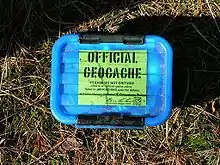
As well as concerns about littering and bomb threats, some geocachers have hidden their caches in inappropriate locations, such as electrical boxes, which may encourage risky behavior, especially by children. Hides in these areas are discouraged,[74] and cache listing websites enforce guidelines that disallow certain types of placements. However, as cache reviewers typically cannot see exactly where and how every cache is hidden, problematic hides can slip through. Ultimately it is also up to cache finders to use discretion when attempting to search for a cache, and report any problems.
Laws and legislation
Regional rules for placement of caches have become complex. For example, in Virginia, the Virginia Department of Transportation and the Wildlife Management Agency now forbids the placement of geocaches on all land controlled by those agencies. Some cities, towns, and recreation areas allow geocaches with few or no restrictions, but others require compliance with lengthy permitting procedures.[88]
The South Carolina House of Representatives passed Bill 3777[89] in 2005, stating, "It is unlawful for a person to engage in the activity of geocaching or letterboxing in a cemetery or in a historic or archaeological site or property publicly identified by a historical marker without the express written consent of the owner or entity which oversees that cemetery site or property." The bill was referred to committee on first reading in the Senate and has been there ever since.[90]
The Illinois Department of Natural Resources requires geocachers who wish to place a geocache at any Illinois state park to submit the location on a USGS 7.5 minute topographical map, the name and contact information of the person(s) wishing to place the geocache, a list of the original items to be included in the geocache, and a picture of the container that is to be placed.[91]
In April 2020, during the COVID-19 pandemic, the township of Highlands East, Ontario, Canada temporarily banned geocaching, over concerns that geocache containers cannot be properly disinfected between finds.[92]
Notable incidents
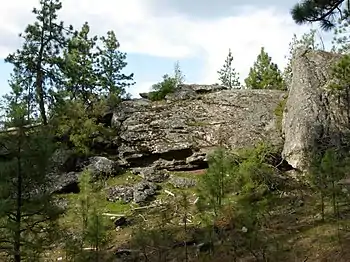
Several deaths have occurred while caching.[93][94][95][96]
The death of a 21-year-old experienced cacher in December 2011 "while attempting a Groundspeak cache that does not look all that dangerous" led to discussions of whether changes should be made, and whether cache owners or Groundspeak could be held liable. Groundspeak has since updated their geocaching.com terms of use agreement to specify that geocachers find geocaches at their own risk.[97]
In 2008, two lost hikers on Mount Hood in Oregon, U.S. stumbled across a geocache and phoned this information out to rescuers, allowing crews to locate and rescue them.[98]
Three adult geocachers, a 24-year-old woman and her parents, were trapped in a cave and rescued by firefighters in Rochester, New York, U.S. while searching for a geocache in 2012. Rochester Fire Department spokesman Lt. Ted Kuppinger said, "It's difficult, because you're invested in it, you want to find something like that, so people will probably try to push themselves more than they should, but you need to be prudent about what you're capable of doing."[99]
In 2015, Her Majesty's Coastguard were called to a group of geocachers who were spotted walking into the Severn Estuary off the coast of Clevedon, England, in search of clues to locate a multi-cache. Although they felt they were safe and able to return to land, they were considered to be in danger and were airlifted back to the shore.[100]
In October 2016, four people discovered a crashed car at the bottom of a ravine in Benton, Washington, U.S., while out geocaching. They spotted the driver still trapped inside and alerted emergency services, who rescued the driver.[101]
On 9 June 2018, four people in Prague, Czech Republic were searching for a cache in a 4 km long tunnel when a storm surge carried them through the tunnel to its terminus at the Vltava river. Two of the geocachers died,[102] while two others were rescued from the river.[103][104]
Websites and data ownership
Numerous websites list geocaches around the world. Geocaching websites vary in many ways, including control of data.
First page
The first website to list geocaches was announced by Mike Teague on May 8, 2000.[105] On September 2, 2000, Jeremy Irish emailed the gpsstash mailing list that he had registered the domain name geocaching.com and had set up his own Web site. He copied the caches from Mike Teague's database into his own. On September 6, Mike Teague announced that Jeremy Irish was taking over cache listings. As of 2012, Teague had logged only 5 caches.[106]
Geocaching.com
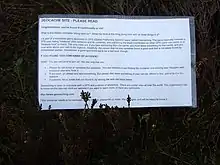
The largest site is Geocaching.com, owned by Groundspeak Inc., which began operating in late 2000. With a worldwide membership and a freemium business model, the website claims millions of caches and members in over 200 countries. Hides and events are reviewed by volunteer regional cache reviewers before publication. Free membership allows users access to coordinates, descriptions, and logs for some caches; for a fee, users are allowed additional search tools, the ability to download large amounts of cache information onto their gps at once, instant email notifications about new caches, and access to premium-member-only caches.[107] Geocaching Headquarters are located in the Fremont neighborhood of Seattle, Washington, United States.[108]
Opencaching Network
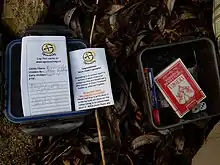
The Opencaching Network provides independent, non-commercial listing sites based in the cacher's country or region. The Opencaching Network lists the most types of caches, including traditional, virtual, moving, multi, quiz, webcam, BIT, guest book, USB, event, and MP3. The Opencaching Network is less restrictive than many sites, and does not charge for the use of the sites, the service being community driven. Some (or all) listings may or may not be required to be reviewed by community volunteers before being published and although cross-listing is permitted, it is discouraged. Some listings are listed on other sites, but there are many that are unique to the Opencaching Network. Features include the ability to organize one's favourite caches, build custom searches, be instantly notified of new caches in one's area, seek and create caches of all types, export GPX queries, statpics, etc. Each Opencaching Node provides the same API for free (called "OKAPI"[109]) for use by developers who want to create third-party applications which can use the Opencaching Network's content.
Countries with associated opencaching websites include the United States at www.opencaching.us;[110] Germany at www.opencaching.de;[111][112] Sweden at www.opencaching.se; Poland at www.opencaching.pl;[113] Czech Republic at www.opencaching.cz; The Netherlands at www.opencaching.nl; Romania at www.opencaching.ro; the United Kingdom at www.opencache.uk.[114][115]
The main difference between opencaching and traditional listing sites is that all services are open to the users at no cost. Generally, most geocaching services or websites offer some basic information for free, but users may have to pay for premium membership that allows access to more information or advanced searching capabilities. This is not the case with opencaching; every geocache is listed and accessible to everyone for free.[114]
Additionally, Opencaching sites allow users to rate and report on existing geocaches. This allows users to see what other cachers think of the cache and it encourages participants to place higher quality caches. The rating system also greatly reduces the problem of abandoned or unsatisfactory caches still being listed after repeated negative comments or posts in the cache logs.[114]
OpenCaching.com
OpenCaching.com (short: OX) was a site created and run by Garmin from 2010 to 2015, which had the stated aim of being as free and open as possible with no paid content. Caches were approved by a community process and coordinates were available without an account. The service closed on 14 August 2015.[110][115][116][117][118][119][120][121][122]
Other sites
In many countries there are regional geocaching sites, but these mostly only compile lists of caches in the area from the three main sites. Many of them also accept unique listings of caches for their site, but these listings tend to be less popular than the international sites, although occasionally the regional sites may have more caches than the international sites. There are some exceptions though, e.g. in the former Soviet Union, the site Geocaching.su remains popular because it accepts listings in the Cyrillic script. Additional international sites include Geocaching.de, a German website, and Geocaching Australia, which accepts listings of cache types deprecated by geocaching.com, cache types such as TrigPoint and Moveable caches, as well as traditional geocache types.
GPSgames
GPSgames.org was an online community dedicated to all kinds of games involving Global Positioning System receivers.[123] GPSgames.org allowed traditional geocaches as well as virtual, locationless, and traveler geocaches. The site's geodashing game generated a large number of randomly positioned "dashpoints", requiring players to reach as many as possible, competing as individuals or teams.[124] Shutterspot, GeoVexilla, MinuteWar, GeoPoker, and GeoGolf were among the other GPS games available.[125]
GPSgames.org was 100% free since 2001, through donations.[126] The site was retired on 30 June 2021.
NaviCache
Navicache.com started as a regional listing service in 2001. While many of the website's listings have been posted to other sites, it also offers unique listings. The website lists nearly any type of geocache and does not charge to access any of the caches listed in its database. All submissions are reviewed and approved.[128] In 2012 it was announced that Navicache was under transition to new owners, who said they "plan to develop a site that geocachers want, with rules that geocachers think are suitable. Geocaching.com and OX are both backed by large enterprises, and while that means they have more funding and people, we're a much smaller team – so our advantage is the ability to be dynamic and listen to the users." However, as of 2021 the site is mostly dormant, and the most recent cache listing is from 2014.[129]
TerraCaching
Terracaching.com seeks to provide high-quality caches made so by the difficulty of the hide or from the quality of the location. Membership is managed through a sponsorship system, and each cache is under continual peer review from other members. Terracaching.com embraces virtual caches alongside traditional or multi-stage caches and includes many locationless caches among the thousands of caches in its database. It is increasingly attracting members who like the point system. In Europe, TerraCaching is supported by Terracaching.eu. This site is translated in different European languages, has an extended FAQ and extra supporting tools for TerraCaching. TerraCaching strongly discourages caches that are listed on other sites (so-called double-listing).[130]
Extremcaching
Extremcaching is a German private database for alternative geocaches with a focus on T5 / climbing caches, night caches, and lost place caches. For extreme caching all you need is an extreme caching account and a GPS device with coordinates or a GPS-enabled smartphone with geocaching or outdoor navigation software, e.g. c:geo.[131][132]
Geocaching Australia
Geocaching Australia is a community website for geocachers in Australia and New Zealand. Geocaching Australia also has many unique cache types such as Burke And Wills, Moveable_cache & Podcache geocaches.[133]
See also
References
- Public Domain Geocaching Logo, retrieved January 12, 2013
- BBC (April 29, 2009). "Geocaching". BBC. Archived from the original on September 8, 2019. Retrieved April 5, 2018.
- Geocaching. "Geocaching - The Official Global GPS Cache Hunt Site". Geocaching. Archived from the original on September 28, 2019. Retrieved October 2, 2019.
- "Fast Facts". Geocaching Newsroom. Retrieved July 25, 2023.
- Geocaching. "Geocaching - The Official Global GPS Cache Hunt Site". Geocaching. Retrieved August 2, 2023.
- Society, National Geographic (January 21, 2011). "geocaching". National Geographic Society. Archived from the original on September 20, 2021. Retrieved December 29, 2016.
- "Geocaching and Letterboxing". Vermont Agency of Natural Resources Department of Forests, Parks and Recreation.
- Thomas, Clive (2010). GPS for Walkers (4th ed.). Ordnance Survey. pp. 64–66. ISBN 978-0-7117-4445-5.
- "Happy 20th birthday, geocaching!". Geocaching.com. Groundspeak. May 5, 2020. Archived from the original on May 10, 2021. Retrieved May 8, 2021.
- "U.S Government: GPS accuracy". Gps.gov. February 17, 2012. Archived from the original on May 2, 2020. Retrieved March 27, 2013.
- "The History of Geocaching". Geocaching. Retrieved September 21, 2021.
- "The History of Geocaching". Geocaching. Groundspeak. Archived from the original on September 8, 2019. Retrieved March 27, 2013.
- Dave Ulmer (May 3, 2000). "GPS Stash Hunt... Stash #1 is there!". Newsgroup: sci.geo.satellite-nav. Usenet: 02b45318.39d4645b@usw-ex0102-084.remarq.com. Archived from the original on September 20, 2021. Retrieved March 18, 2014.
- Parry, Cristina (April 29, 2009). "Geocaching". BBC News Oxford. Archived from the original on September 8, 2019. Retrieved March 3, 2019.
- "GCGV0P- Original Stash Tribute Plaque". Geocaching.com. Geocaching HQ. September 7, 2003. Archived from the original on February 18, 2013. Retrieved March 27, 2013.
- "O.C.B.©". Geocaching.com. September 7, 2003. Archived from the original on February 21, 2018. Retrieved February 21, 2018.
- "GC1BE91 International Space Station". Geocaching. Archived from the original on May 30, 2013. Retrieved March 27, 2013.
- "Geocaching map". Geocaching. Archived from the original on January 5, 2014. Retrieved January 24, 2014.
- Geocaching. "GC1BE91 - International Space Station".
- "Mars Perseverance Rover". geocaching.com. Archived from the original on February 22, 2021. Retrieved February 19, 2021.
- "5 Hidden Gems Are Riding Aboard NASA's Perseverance Rover". NASA's Mars Exploration Program. Archived from the original on February 22, 2021. Retrieved February 22, 2021.
- Stum, Matt (May 30, 2000). "Cache vs Stash". Yahoo!. Archived from the original on April 4, 2011. Retrieved May 21, 2007.
- "Hide And Seek GPS And Geocaching In The Classroom | Download Citation". ResearchGate. Archived from the original on September 20, 2021. Retrieved March 28, 2019.
- The History of Geocaching Archived August 1, 2013, at the Wayback Machine GPSgames.org; retrieved January 12, 2013
- Spencer, Susan (November 10, 2012). "New game in town, Nerds gain more revenge with Munzee". Telegram & Gazette. Archived from the original on June 7, 2013. Retrieved January 20, 2013.
- "The beginners' guide to geocaching". Countryfile Magazine. February 12, 2015. Archived from the original on February 2, 2017. Retrieved January 22, 2016.
- "Glossary of Terms". Geocaching.com. Groundspeak, Inc. Archived from the original on October 1, 2015. Retrieved September 30, 2015.
- Brigitte (May 12, 2018). "The difference between SWAG and trackables". Official Blog. Archived from the original on February 6, 2021. Retrieved February 27, 2021.
- Sherman, Erik (2004). Geocaching hike and seek with your gps (Steve Anglin ed.). Berkeley: APRESS. p. 19. ISBN 1-59059-122-4.
- Ng, Hedy (August 19, 2016). "Pokemon who? Richmond geocachers are the real life scavenger hunters". Richmond News. Archived from the original on January 7, 2017. Retrieved January 7, 2017.
- Griffin, Mary (August 12, 2014). "Geocaching: Join the global treasure hunt this summer holidays". Coventry Telegraph. Archived from the original on August 7, 2020. Retrieved May 12, 2020.
- Geocaching. "Geocaching - The Official Global GPS Cache Hunt Site". Geocaching. Archived from the original on December 2, 2014. Retrieved February 27, 2021.
- H, Derek (June 25, 2015). "gigantesque – The Big One (GC5Q8N) – Geocache of the Week". Archived from the original on June 29, 2015. Retrieved June 30, 2015.
- "Geocache types". geocaching.com. Groundspeak. Archived from the original on September 2, 2006. Retrieved January 16, 2017.
- "Cache Parameters". wiki.opencaching.us. Opencaching Network. Archived from the original on October 19, 2012. Retrieved January 16, 2017.
- "Challenge caches". geocaching.com. Groundspeak. Archived from the original on June 22, 2019. Retrieved September 8, 2019.
- "The history of traveling caches". geocaching.com. Groundspeak. Archived from the original on August 4, 2020. Retrieved September 8, 2019.
- Garmin chirp Brings Geocachers Even More Creativity, Connectivity Archived March 1, 2012, at the Wayback Machine, published October 15, 2010
- Garmin Chirp Archived March 2, 2013, at the Wayback Machine, retrieved January 13, 2013
- Garmin Chirp- Geocaching Beacon Archived July 22, 2013, at the Wayback Machine, retrieved January 13, 2013
- "Night and UV Caches". Groundspeak. Archived from the original on October 31, 2020. Retrieved January 16, 2016.
- Geocaching. "GCK25B - Geocaching HQ". www.geocaching.com. Retrieved August 2, 2023.
- "Wherigo > About the Wherigo Platform". Wherigo.com. Groundspeak. Archived from the original on February 23, 2019. Retrieved November 20, 2011.
- "Wherigo Builder". Wherigo.com. Groundspeak. Archived from the original on February 23, 2019. Retrieved November 3, 2013.
- "Wherigo Foundation". WherigoFoundation.com. WherigoFoundation. Archived from the original on February 23, 2019. Retrieved March 13, 2014.
- "Virtual Geocaches". Groundspeak.com. Archived from the original on April 3, 2014. Retrieved January 24, 2014.
- Geocache Listing Requirements / Guidelines Archived January 12, 2013, at the Wayback Machine, retrieved January 12, 2013
- "Virtual Rewards". geocaching.com. August 24, 2017. Archived from the original on November 12, 2017. Retrieved November 11, 2017.
- "EarthCache". Geological Society of America. Retrieved October 2, 2022.
- "GPX: The GPS Exchange Format". Archived from the original on April 20, 2014. Retrieved July 20, 2009.
- geobeagleteam. "GeoBeagle: an Android app for geocaching and letterboxing". Google codes projects. Google Project Hosting. Archived from the original on December 26, 2012. Retrieved January 22, 2013.
- Bardua, Joachim (May 18, 2010). "GeoBeagle – Geocaching Apps für Android Smartphones (5) (GeoBeagle - Geocaching apps for Android smartphones (5))". Navigation-Professionell. Archived from the original on March 2, 2013. Retrieved January 22, 2013.
- Cutler, Kim-Mai (August 9, 2009). "Augmented reality meets scavenger hunt with GeoBeagle, Wikitude". Venturebeat. Archived from the original on January 11, 2013. Retrieved January 22, 2013.
- "Outdoor-Navigation mit dem Garmin Colorado 300" (in German). connect.de. April 1, 2008. p. 1. Archived from the original on December 20, 2008. Retrieved November 25, 2008.
- ${l.c}. "geocaching.com". geocaching.com. Retrieved March 27, 2013.
- "Geocaching > API Partner Applications". Archived from the original on February 13, 2017. Retrieved February 12, 2017.
- "c:geo – FAQ". cgeo.org. Archived from the original on June 7, 2012. Retrieved January 17, 2017.
- "cgeo.org". cgeo.org. Archived from the original on April 2, 2013. Retrieved March 27, 2013.
- Lim, Ian (November 2, 2011). "c:geo Geocaching App for Android Review". The Gadgeteer. Archived from the original on March 26, 2013. Retrieved January 21, 2013.
- Kilián, Karel (January 14, 2013). "c:geo: vyšla další aktualizace (c: geo: published more updates)". Archived from the original on January 20, 2013. Retrieved January 21, 2013.
- Schön, Otakar (January 4, 2013). "Nexus 4 na chvíli v redakci IHNED.cz: Krásný a extrémně rychlý telefon od Googlu Vyzkoušeli jsme novou generaci telefonu Nexus, který pro Google (Nexus 4, while in the newsroom IHNED.cz: Beautiful and extremely fast phone from Google)". ihned.cz. Archived from the original on January 7, 2013. Retrieved January 21, 2013.
- Bardua, Joachim (April 27, 2010). "c:geo – Geocaching Apps für Android Smartphones (1) (c: geo - geocaching apps for Android smartphones (1))". Navigation-Professionell. Archived from the original on March 2, 2013. Retrieved January 22, 2013.
- "c:geo – Geocaching for Android". cgeo.org. Archived from the original on November 5, 2015. Retrieved November 5, 2015.
- "Finding Einstein: Geocaching with dGPS | | Dexter Industries BlogDexter Industries Blog". Dexterindustries.com. Archived from the original on August 15, 2012. Retrieved July 15, 2012.
- Denmead, Ken. "Articles on Lego Mindstorms". wired.com. Archived from the original on November 13, 2013. Retrieved March 7, 2017.
- Fredrick Kunkle, Geocaching Craze Pushes Officials To Set Guidelines Archived December 1, 2018, at the Wayback Machine, Washington Post, September 27, 2007. Retrieved March 11, 2008.
- "Geocaching puts some authorities on edge". Associated Press. January 17, 2006. Archived from the original on March 6, 2016. Retrieved January 2, 2009.
- "GAGB – Agreements Database". GAGB Land Agreements Database. Archived from the original on September 8, 2019. Retrieved October 2, 2009.
- "Suspicious Package Not a Bomb". MyWestTexas.com. Archived from the original on September 4, 2012. Retrieved January 10, 2010.
- Dahlberg, Johan (2011). Experiences from the Field. The Geocaching Pocket Series. p. 34.
- Corum, Molly (July 6, 2011). "Geocaching: Awesome Scavenger Hunt, or Bomb Threat Waiting to Happen?". International Business Times. Archived from the original on September 27, 2020. Retrieved January 23, 2013.
- Savage, Danny (July 5, 2011). "Geocaching: the unintended results". BBC News. Archived from the original on November 12, 2020. Retrieved January 17, 2013.
- Bokros, Tom (June 3, 2020). "This is what the suspicious package found in Derby really was". Derby Telegraph. Archived from the original on November 27, 2020. Retrieved June 3, 2020.
- Mike Vogel. "Geocache player broke all the rules of Internet treasure hunt". Boise, Idaho. Archived from the original on December 2, 2008. Retrieved September 28, 2005.
- Turner, Ramona (May 22, 2009). "Bomb scare closes main entrance to UCSC". Archived from the original on August 29, 2018. Retrieved March 19, 2018.
- "Detonated 'bomb' turns out to be box of toys". The Deseret News. November 12, 2005. Archived from the original on June 29, 2018. Retrieved August 7, 2009.
- "One person's game is another's bomb scare". Ottawa Citizen. July 29, 2008. Archived from the original on December 2, 2008.
- Rocha, Veronica (January 14, 2013). "Suspicious object found on Glendale power pole determined to be safe". Glendale News-Press. Archived from the original on March 28, 2014. Retrieved January 17, 2013.
- Rochelle, Anna (September 5, 2012). "Suspected pipe bomb ends up being geocache tube". Greene County Daily World. Archived from the original on May 23, 2013. Retrieved January 21, 2013.
- Jason, Kandel (March 4, 2012). "Geocaching Game Triggers Disneyland Lockdown". NBCUniversal, Inc. Archived from the original on August 16, 2013. Retrieved January 21, 2013.
- "Does Geocaching Violate Leave No Trace? - Backpacker". Backpacker. May 7, 2008. Archived from the original on February 2, 2017. Retrieved December 29, 2016.
- Loranger, Derek (December 22, 2012). "Geocaching - Organised Littering?". 100 Peaks. Archived from the original on September 23, 2018. Retrieved February 27, 2018.
- Boehrer, McGonial, Katherine, Chris (September 28, 2014). "Oh The Places You'll Go: Geocaching Takes Adventurers To Beautiful, New Spots Every Day". Huffington Post. Archived from the original on February 28, 2018. Retrieved February 27, 2018.
{{cite news}}: CS1 maint: multiple names: authors list (link) - "Advice to Geocache Hiders from Law Enforcement". The Geocaching Blog. September 4, 2013. Archived from the original on September 23, 2018. Retrieved December 22, 2016.
- Nathan, Freddie (March 26, 2013). "Geocaching craze leaves York residents underwhelmed". The Independent. Archived from the original on July 26, 2020. Retrieved July 26, 2020.
- "Police Search For Gamer Who Hung Geocache From Railroad Overpass". The Naperville Sun and CBS Chicago. June 3, 2011. Archived from the original on July 4, 2013. Retrieved January 23, 2013.
- "GAGB Geocache labels". Geocaching Association of Great Britain. Archived from the original on November 4, 2020. Retrieved January 17, 2017.
- Groundspeak's Wiki for Virginia's land management policies Archived September 18, 2020, at the Wayback Machine, retrieved January 12, 2013
- 2005–2006 Bill 3777: Geocache, geocaching, and letterboxing Archived September 26, 2009, at the Wayback Machine South Carolina Legislature Online
- Haynie, Rachel (May 20, 2005). "High–tech scavenger hunt Geocachers invade hallowed ground". Columbia Star. Archived from the original on December 28, 2016. Retrieved March 3, 2010.
- "Recreation". dnr.illinois.gov. Archived from the original on October 19, 2020. Retrieved October 2, 2019.
- "Public beaches, geocaching and mineral collection sites closed". Municipality of Highlands East. April 2, 2020. Archived from the original on February 12, 2021. Retrieved May 12, 2020.
- "Valley man geocaching in Dishman Hills before fatal fall Archived April 12, 2017, at the Wayback Machine"- YouTube. Uploaded on Nov 18, 2009, retrieved January 12, 2013
- Man dies in cliff fall at Dishman Hills Natural Area Archived November 5, 2013, at the Wayback Machine, published November 16, 2009
- "Cave Creek man, 79, found dead Archived August 18, 2020, at the Wayback Machine" (2012-07-08) Scott, Luci. azcentral.com. Retrieved 2017-01-17.
- "The Body of a Missing Hiker Only Found Because of His Dog Barking Until Help Came Archived February 5, 2021, at the Wayback Machine" (2019-05-08) Williams, Doug. Outdoor Revival
- "TERMS OF USE AGREEMENT 2A. Inherent Risks". Groundspeak. June 27, 2016. Archived from the original on February 2, 2021. Retrieved January 11, 2017.
- "Geocaching saves the day for lost hikers - Garmin Blog". Garmin. January 17, 2008. Archived from the original on November 12, 2020. Retrieved May 3, 2014.
- Carroll, Sean (August 14, 2012). "Three Hikers Rescued From Cave Were Geocaching". 13 ABC WHAM. Archived from the original on February 19, 2013. Retrieved January 23, 2013.
- "Rescued Clevedon geocachers were 'never in danger'". BBC News. April 20, 2015. Archived from the original on November 8, 2020. Retrieved January 11, 2017.
- "Geocachers Save A Woman's Life". The Geocaching Blog. November 17, 2016. Archived from the original on September 8, 2019. Retrieved January 11, 2017.
- Kenety, Brian (June 15, 2018). "Second body found in Vltava River that of missing geocacher | Radio Prague". Radio Praha. Archived from the original on July 20, 2018. Retrieved April 1, 2019.
- "Povodeň v pražském podzemí: Jak se čtveřice lidí sama dostala do smrtelného nebezpečí - Seznam Zprávy". seznamzpravy.cz. Archived from the original on February 13, 2021. Retrieved June 11, 2018.
- "Policie obnovila pátrání po lovci pokladů, potvrdila identitu utonulé ženy". iDNES.cz. June 9, 2018. Archived from the original on June 12, 2018. Retrieved June 11, 2018.
- "Geocaching - Early History - Fun Facts, Questions, Answers, Information". Archived from the original on July 13, 2015. Retrieved January 17, 2017.
- "Interview: Mike Teague On The First Geocache Listing Site". Awesome Geocaching. August 14, 2012. Archived from the original on October 22, 2012. Retrieved June 15, 2014.
- Geocaching.com's Premium Membership Benefits Archived August 10, 2015, at the Wayback Machine Retrieved June 25, 2013.
- Schlosser, Kurt (August 19, 2022). "No hiding from its popularity: At 20, Geocaching still seeks to turn players on to worldwide game". GeekWire. Retrieved August 20, 2022.
- "Opencaching Network API". GitHub. Archived from the original on November 24, 2020. Retrieved February 14, 2016.
- "The Joys of Geocaching". East County Magazine. Archived from the original on April 1, 2019. Retrieved March 17, 2019.
- Gründel, Markus (2009). Geocaching: Basiswissen für Draussen (in German). Conrad Stein Verlag, GmbH. ISBN 978-3866862722.
- NDR. "Geocaching: Wie funktioniert das?". ndr.de (in German). Archived from the original on October 17, 2020. Retrieved March 17, 2019.
- "Geocaching - co to jest i na czym polega?". pcformat.pl. Archived from the original on April 28, 2020. Retrieved March 17, 2019.
- "OpenCaching United States Wiki". Archived from the original on July 21, 2020. Retrieved January 12, 2013.
- comments, 30 Sep 2014 Heiko W. RuppFeed 167up 2. "The geocaching experience is catching". Opensource.com. Archived from the original on November 11, 2020. Retrieved March 17, 2019.
- "Try a family treasure hunt for the GPS generation". The Independent. June 12, 2011. Archived from the original on April 1, 2019. Retrieved March 17, 2019.
- "Google Translate". translate.google.com. Archived from the original on September 8, 2019. Retrieved March 17, 2019.
- Kuruc, Jiří. "Garmin spouští OpenCaching: porazí Geocaching?". Navigovat.MobilMania.cz (in Czech). Archived from the original on October 26, 2020. Retrieved March 17, 2019.
- "Four new Oregon touchscreen GPS devices pop up on Garmin's website (updated)". Engadget. Archived from the original on April 1, 2019. Retrieved March 17, 2019.
- "6 of the best... walking gadgets to get you fitter". BelfastTelegraph.co.uk. ISSN 0307-1235. Archived from the original on April 1, 2019. Retrieved March 17, 2019.
- Martinez, Kara (January 28, 2015). "Free things to do on the north shore: Become a treasure hunter with geocaching". nola.com. Archived from the original on April 1, 2019. Retrieved March 17, 2019.
- "Scavenger-hunt hobby geocaching gaining popularity". The News-Press. Archived from the original on September 20, 2021. Retrieved March 17, 2019.
- "About GPSgames.org". Archived from the original on September 16, 2013. Retrieved January 12, 2013.
- Sherman, Erik (April 12, 2004). Geocaching: Hike and Seek with Your GPS. Apress. p. 72. ISBN 978-1-4302-0680-4.
- "GPS Games". Archived from the original on September 16, 2013. Retrieved January 12, 2013.
- "GPSgames.org". Archived from the original on April 6, 2013. Retrieved January 12, 2013.
- "Navicache Geocaching FAQ". Archived from the original on May 16, 2013. Retrieved January 12, 2013.
- "Am Wasserhaus". navicache.com/. Retrieved December 27, 2021.
- "Welcome to TerraCaching.com". Archived from the original on January 15, 2013. Retrieved January 12, 2013.
- "Google Translate". translate.google.com. Archived from the original on September 8, 2019. Retrieved March 17, 2019.
- "Extremcaching - T5 + Lost Place Geocaching". extremcaching.com (in German). Archived from the original on April 1, 2019. Retrieved March 17, 2019.
- "Geocaching Australia". wiki.geocaching.com.au/wiki/Geocaching_Australia. Archived from the original on June 9, 2020. Retrieved June 9, 2020.
Further reading
- Gillin, Paul; Gillin, Dana (2010). The Joy of Geocaching. Fresno, California: Quill Driver Books. ISBN 978-1884956997.
- Mike Dyer (August 15, 2004). The Essential Guide to Geocaching. Fulcrum Publishing. ISBN 978-1555915223.
- Jack W. Peters (2004). The Complete Idiot's Guide to Geocaching. Indianapolis: Alpha Books. ISBN 1-59257-235-9.
- Joel McNamara (September 3, 2004). Geocaching For Dummies. For Dummies. ISBN 978-0764575716.
- Erik Sherman (April 2004). Geocaching: Hike and Seek with Your GPS. Apress. ISBN 978-1590591222.
- Cameron, Layne; Ulmer, Dave (July 1, 2004). The Geocaching Handbook (Falcon Guide). Falcon. ISBN 978-0-7627-3044-5.
- John McKinney (2008). Let's Go Geocaching. DK Publishing. ISBN 978-0756637170.
- CQ Products (July 23, 2007). It's a Treasure Hunt! Geocaching & Letterboxing. G & R. ISBN 978-1563832680.
- Jeannette Cézanne (2007). "And have a great time geocaching with some gummy bears". Open Your Heart with Geocaching: Mastering Life Through Love of Exploration. DreamTime Pub., Incorporated. ISBN 978-1601660046.
External links
- Geocaching at Curlie
- In Wisconsin: Geocaching Video produced by Wisconsin Public Television
- FTF Geocacher Magazine Print Magazine devoted to geocaching
- geocaching.com The official geocaching website
